|
Rankings:
• God Tier: The difference between this and a top tier may well lie in that difficult-to-quantify person connection, or "pconnects" in DDD lingo. This album is one that you can't imagine living without. It's one you speak about in hushed tones and will gush to anyone about if they let you. Sometimes a top tier album will bump up to this tier after a particularly memorable listening experience.
• Top Tier: Top tiers are consistently great. They're what you hope for when you hit play on that new record you bought. You'll come back to it time and again because of it's great sequencing, great sound, and bevy of awesome songs. An occasional misstep might be present but will be forgotten by album's end.
• High Tier: This album is solid. Sure, there are missteps, but if you take a step back it's a competent album. It might even have some incredible moments that are brought down by filler.
• Mid Tier: A low tier album is all over the place - or consistently bland. It may have some genuinely great moments, but these are off-set by terrible ones. Most of the time though, a mid tier album just fails to make an impression either way. A single fantastic song can easily bump up an otherwise awful album into this tier.
• Low Tier: A low tier album is a major disappointment. Almost devoid of redeeming moments, it can be a real hassle to listen to - or it might just be a bore. The occasional glimpse of musical enjoyment is not enough to lift this album out of the dreaded low tier. It is rumored that a special tier below this one is reserved for albums that are not just disappointing, but actually serve to discredit music as a form of art...
|
Introduction |
|
First, some background on what is and isn't a John Coltrane album. This guy's discography is enormous, and baffling no thanks to the endless sessions he did with Prestige and the frequent practice of not releasing sessions until many years after they were recorded. This makes the task of finding the definitive Coltrane "canon" extremely difficult and totally subjective. I've done my best to come up with a list of "core" Coltrane albums where he was either the leader or the main player. I hope that this list is useful to people trying to get into Coltrane, especially if they have a completionist bent.
Jazz in the '50s was really not an album-oriented scene, rather musicians got together in whatever configuration was working that week and had a "blowing session" which was recorded, and if it produced enough good material then it was cut to wax. Editing, sequencing, and painstaking studio mixing and mastering were not high on the agenda. This of course all began to change as the jazz world got closer and closer to Bitches Brew, but in Coltrane's time, the majority of his output was not recorded with a specific album in mind. Each session was a snapshot of what the ever-evolving group was playing at that moment in time. Of course, when Coltrane did set out to record a specific suite of music with the intention of producing a coherent album, wonderful things happened.
In the Prestige era especially, Coltrane played sessions almost every week, and for many of these he was not session leader. This produced a lot of vaguely-attributed albums where you might not consider them Coltrane albums at all. Aside from the sessions where Coltrane was explicitly leader, which I have included all of, I threw in a bunch of albums which Prestige re-released as Coltrane albums just to boost their sales, even when he wasn't really the leader in the sessions that produced them.
Coltrane also did a bunch of collaborations with other artists as co-leader. I've included all of these, however I've left out his work with Thelonious Monk and Miles Davis, as he was definitely a subordinate member of those bands rather than a collaborator or leader.
Secondly – Live. There are a huge number of live recordings of Coltrane out there, most of which were never released on his main labels. Those might be a future project, but I have included in this series all the live albums that were issued on the labels he recorded studio albums with. These albums are essential parts of the discography as a whole, and since jazz is a genre rooted in live performance I see no special reason to divide the two like I would with a rock or pop artist.
I am going to review the albums in roughly chronological order. I say that because sometimes albums were culled from disparate sessions spanning over a year. Any that fall into that category I'll place in the timeline at the point where the majority of the album was recorded. The only truly posthumous album that was recorded after John's death was Infinity, which I included just for the heck of it. It sets existing recordings of him to newly-recorded backing music, much the same as Jim Morrison's An American Prayer.
|
|
Part I - The Early Period |
|
Trane did plenty of albums before this as a sideman, notably with Miles Davis's first great quintet, but I won't review those here because they belong to Miles. The records below are ones where Coltrane played on every track and where there was no session leader. They were all later marketed as Coltrane albums despite this. Albums where Coltrane was a sideman but not leader nor co-leader I have omitted from this series.
In this period, John was an up-and-coming Tenor player who had been on the scene for over a decade but never really made much of a splash until he was hired by Miles Davis. Even in his time in the first great quintet he never really hit his stride (although to audiences at the time he was considered an amazing player). He was struggling with a heroin addiction at the time, and although I don't think it shows in his playing, it definitely prevented him from being able to take charge of a band. His consistent playing in this period got him more and more recognition. Plenty of musicians were clamouring to feature him by the beginning of 1957.
|
|
Two Tenors
(a.k.a. "Informal Jazz" – originally released by Elmo Hope Sextet. Co-leader with Hank Mobley.)
Recorded: May 1956
Released: 1956
Label: Prestige
Elmo Hope – piano
Donald Byrd – trumpet
John Coltrane – tenor saxophone
Hank Mobley – tenor saxophone
Paul Chambers – bass
Philly Joe Jones – drums
|
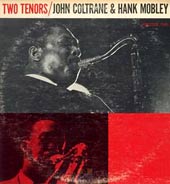
|
|
• Mid Tier
John appeared on plenty of tracks and albums before Two Tenors, but never was he featured as strongly as in that record. When Prestige re-released it, they dropped the "Elmo Hope Sextet" as the artist and retroactively called it a John Coltrane/Hank Mobley collaboration. And when you listen to it it's obvious that that's what it was. Elmo himself barely features. With that little upgrade, it makes this album (by my count) the earliest LP that could be considered to belong to the man himself!
The album is fairly stock-standard hard-bop of the time, and the rhythm section of Chambers and Philly Joe were very familiar to Coltrane. Donald Byrd's classic style doesn't feature as much as it could, but when it does it's beautiful, particularly on ballad "Polka Dots and Moonbeams". Hank and Trane don't sound all that different to each other in this period. Trane in particular utilised the low end of his range a whole bunch, and sounds more like Stan Getz than his usual self. The two tenors that gave the record its (re)title interact pretty well. Everyone should enjoy their 4-bar duel on "On Ot" where Coltrane's famous dark tone finally comes out enough to contrast heavily with Mobley.
|
|
Tenor Conclave
(with Hank Mobley, Al Cohn, and Zoot Sims)
Recorded: September 1956
Released: 1957
Label: Prestige
Al Cohn – tenor saxophone
John Coltrane – tenor saxophone
Zoot Sims – tenor saxophone
Hank Mobley – tenor saxophone
Red Garland – piano
Paul Chambers – bass
Art Taylor – drums
|
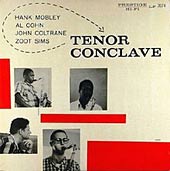
|
|
• High Tier
Who put all these tenors in this conclave? Sadly, all four tenors are rarely used at once on this LP, save for the head of "Bob's Boys" which has some gorgeous harmonies. Still, this record sounds brilliant, and slow burner "How Deep Is the Ocean" is a real treat and doesn't outstay its welcome despite being 15 minutes long.
|
|
Interplay
(for Two Trumpets and Two Tenors) (as the "Prestige All-Stars")
Recorded: March 1957
Released: 1957
Label: Prestige
John Coltrane – tenor saxophone
Bobby Jaspar – tenor saxophone
Idrees Sulieman – trumpet
Webster Young – trumpet
Mal Waldron – piano
Kenny Burrell – guitar
Paul Chambers – bass
Art Taylor – drums
|

|
|
• High Tier
This is another of Prestige's experiments with throwing their working players into the studio and seeing what comes out.
If you just throw this on in the background you're probably not going to get much out of it, but it's great to hear those moments of Coltrane brilliance (who, let's face it, destroys the other horn players on here) where he really gets under the skin of the chord progression. Check out his solo on "Light Blue" compared to the forgettable solo by Bobby Jaspar. You'll know which is which. Kenny Burrell is also a highlight of this album. My only complaint is that he plays so rarely, soloing only on a few cuts and leaving most of the comping to pianist Mal Waldron. "Soul Eyes" is a great, slow track, but boy is it long.
|
|
Dig It!
(as the "Red Garland quintet with John Coltrane")
Recorded: March 1957 to February 1958
Released: 1962
Label: Prestige
John Coltrane – tenor saxophone
Red Garland – piano
Donald Byrd – tp
George Joyner/Paul Chambers – bass
Art Taylor – drums
|
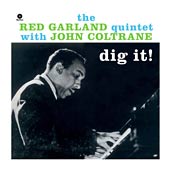
|
|
• High Tier
Immediately you can hear that Trane is feeling comfortable. In this quintet environment he absolutely shines, and comes right out of the gate with a powerful and challenging solo on "Billie's Bounce". "Crazy Rhythm" is a great little trio track that really shows how good Red's chops were, and then on "C.T.A." Coltrane gets a heap more breathing room than on the version found on Interplay. Side B is filled with another long blues, "Little Mae", but there’s some seriously great stuff in there, particularly from the bassist.
|
|
The Cats
(with Tommy Flanagan, Kenny Burrell, Idrees Sulieman)
Recorded: April 1957
Released: 1959
Label: Prestige
Idrees Sulieman — trumpet
John Coltrane – tenor saxophone
Tommy Flanagan — piano
Kenny Burrell — guitar
Doug Watkins — bass
Louis Hayes — drums
|
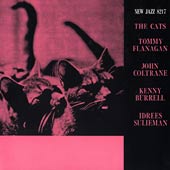
|
|
• Mid Tier
This combo works great together. The rhythm section is a big contrast from the last few Prestige records. John and Tommy seem to mesh really well together compared to previous horn lineups. Also really cool to hear a totally different style of song in "Eclypso" which explains itself. Highlight of the record is "Solacium" with its beautiful group playing on the head. In this period, Coltrane's explorations sound best when he's grounded by a strong chord progression that's inherently melodic, and "Solacium" is the perfect example of that.
|
|
Dakar
(a.k.a. Baritones and French Horns as the "Prestige All-Stars")
Recorded: April 1957
Released: 1957
Label: Prestige
John Coltrane – tenor saxophone
Cecil Payne - baritone saxophone
Pepper Adams - baritone saxophone
Mal Waldron – piano
Doug Watkins – bass
Art Taylor – drums
|
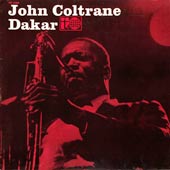
|
|
• High Tier
Cecil and Pepper dominate this record. Coltrane holds up well of course, but their deep and powerful horns rip up every track, particularly "Route 4" and the title track. It seems like the recording quality has taken a jump on this record too - every time that bass and piano comes up a little in the mix, the band as a whole sounds much better. The other thing that is quality on this record are the tunes themselves, which are genuinely catchy (which outside of the standards, cannot be said for previous Prestige efforts). This is a really good session where Trane is just on the cusp of becoming a leader. Although Pepper and Cecil are the standouts here, it's John that holds everything together.
|
|
Cattin' with Coltrane and Quinichette
(co-leader with Paul Quinchette)
Recorded: May 1957
Released: 1959
Label: Prestige
John Coltrane – tenor saxophone
Paul Quinichette – tenor saxophone
Julian Euell – double bass
Ed Thigpen – drums
Mal Waldron – piano
|
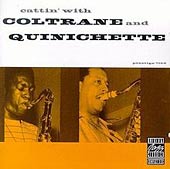
|
|
• Low Tier
Not one of the better releases, this album sees some pretty forgettable tunes and is brought down by Quinchette's lacklustre playing. I will throw a bone to "Anatomy", where John takes a rather impressive solo. Other than that not much is going to stand out.
|
Part 1 Part 2 Part 3 Part 4 Part 5 Part 6
|